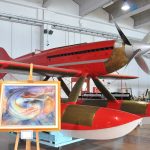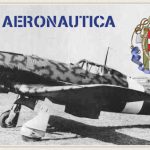
By Luigino Caliaro
Sunday April 29th, 1945 marked the first weekend following the effective cessation of hostilities in Italy during WWII. At the military barracks in Milan, only recently occupied by the Garibaldi Rocco and Redi partisan brigades, the officers of 1° Gruppo Caccia of the RSI (Repubblica Sociale Italiana) were gathered, following the signing of their surrender by the unit’s commander, Maggiore Adriano Visconti. This document signed with the partisans allowed the officers an honorable surrender, while the NCOs and troops were set free, with guarantees of personal safety for all parties. Visconti had arrived at the decision to sign the surrender document with considerable reservations. Nevertheless, his desire to spare more useless bloodletting prevailed over the pride of a soldier, and after praising the efforts of his men following more than a year of combat operations in almost impossible conditions, he placed his signature on the document. He remained convinced that despite this surrender, 1° Gruppo of the RSI had conducted itself with honor until the final days of the war, performing its duty as a defender of the Italian people. In the early afternoon, some partisans summoned Maggiore Visconti from his quarters, on the pretext of an investigation, and he duly reported with his aide, Sottotenente Valerio Stefanini. As the two men crossed the courtyard, a few bursts of machine gun fire rattled out, echoing loudly across the building, an ill omen of what was later publically confirmed by the partisans themselves. Totally against the agreement previously signed by all parties, Maggiore Visconti, the charismatic Comandante of the 1° Gruppo Caccia RSI, and Sottotenente Stefanini, had been assassinated by some of the partisans, who fired a deadly burst of machine gun fire into their backs as the two officers walked to their appointment. In this tragic way, the life of one of the most respected Italian fighter pilots was brought to a sad end, a much loved commander who led one of the famous fighter groups that fought tirelessly and with limited equipment against the overwhelming power of the Allied air forces which ranged across the skies of Northern Italy during the final year of World War Two.
Adriano Visconti was born in Libya on November 11th, 1915, and following high school, he enrolled in the REX course at the Accademia Aeronautica, the fabled Air Force Academy for the Regia Aeronautica (Royal Italian Air Force) in Caserta, Italy. Becoming a military pilot in 1939, he was soon posted to the 159a Squadriglia (Squadron) of the 50°Stormo (Wing), based at the time in North Africa and equipped with the disappointing Breda Ba.65 attack aircraft. Visconti didn’t stay long with the unit as, following disciplinary action, the commander transferred him to a liaison unit flying the Caproni Ca.309 Ghibli twin engined transport/reconnaissance aircraft. He distinguished himself in combat flying one of these ungainly-looking beasts by successfully surviving an attack by three RAF Gloster Gladiators, earning himself a Medaglia di Bronzo al Valore (Bronze Medal of Valor). Posted back to 159°Squadriglia, Visconti completed his operational tour, remaining with the unit until its disbandment in January, 1941. Visconti then joined 76a Squadriglia, a fighter unit assigned to 7° Gruppo (Fighter Group) of 54°Stormo, and commenced his career as a fighter pilot flying in the Macchi MC.200 Saetta. Despite intense flying activity, Visconti’s first victory didn’t come until June 15th, 1942, by which point his squadron had upgraded to the far more potent Macchi MC.202 Folgore. This combat occurred during the Battle of Pantelleria at the end of an air engagement when he managed to shoot down a British Bristol Blenheim. A few weeks later, on August 13th, Visconti added two RAF Spitfires to his account.
Visconti had to wait for a few more months before officially becoming an ace. Returning with his unit from North Africa in April 1943, he managed to down two enemy aircraft over Bourigne: a Spitfire on April 8th and an American P-40 Warhawk on April 29th. Soon after, Visconti became Comandante (Commander) of the newly constituted 310a Squadriglia Caccia Fotografica (Photo Reconnaissance Squadron). Just prior to leaving his old unit he managed to shoot down a Spitfire Mk.V on May 6th over Cape Bon, although there is some evidence that this is unconfirmed. Visconti’s posting to a photo-reconnaissance unit was certainly linked to the experience that he had previously acquired, as on many occasions he had flown surveillance missions in MC.200 and MC.202 fighters modified to house cameras. Towards the end of August, 1943, Visconti managed to operationally deploy an initial section of Macchi MC.205V, a long range, drop tank equipped version of the Veltro. He flew on the first operational sortie on August 28th; a reconnaissance mission lasting almost two hours.
The Armistice of September 8th, 1943 came like a bolt from a clear sky and Visconti, completely isolated and without orders, returned to Rome to try and gain a better understanding of the events that were unfolding, and also to avoid any possible reprisal from German forces still present at their base in Decimomannu, Sardinia. Eventually, still without any instructions on how his unit should behave, and without any transport aircraft to evacuate his personnel, Visconti decided to fly the unit’s fighters to mainland Italy. The journey brought the majority of the pilots home, sharing cockpits as a last resort. They arrived at Guidonia, near Rome, with a flight of three single seat Macchi MC.205Vs disembarking some 11 pilots!
In those moments of absolute confusion, Visconti took the decision to adhere to the RSI (the Repubblica Sociale Italiana), maintaining faith in his original military oath of allegiance, and was assigned to the 1° Gruppo Caccia, equipped with the Macchi MC.205. This choice is clear evidence of Visconti’s character and patriotic spirit. He was not particularly pro-German, and this is confirmed by the fact that it was Visconti himself who requested the overpainting of German crosses on the RSI’s fighters with the Italian national insignia, albeit slightly different to those used in the early years of the war. Visconti soon took command of 1a Squadriglia, and began to fly the Veltro on desperate missions to counter American bombing raids, engaging in furious combat with their P-38 and P-47 escorts. On January 3rd, 1944, a P-38 Lightning would become his first victim while serving with the RSI, and in the course of the following months he obtained a further three confirmed victories before receiving command of 1° Gruppo Caccia posted to Germany for conversion onto the Messerschmitt BF-109G-6, the aircraft in which he would fly during the final months of the war, prior to its tragic epilogue.
Maggiore Visconti, over the course of five years of war, was decorated with four Medaglie d’Argento (Silver Medals) and two Bronzo (Bronze Medals) for valor, and the German Iron Cross class I and II. In total, he was credited with ten confirmed victories and 26 probables.
CONFIRMED AIR COMBAT VICTORIES
AIRCRAFT FLOWN LOCATION DATE AIRCRAFT DESTROYED
1) Mc 202 Pantelleria 15-6-42 Bristol Blenheim
2) Mc 202 Mediterranean 13-8-42 Spitfire V
3) Mc 202 Mediterranean 13-8-42 Spitfire V
4) Mc 202 Bourgine 8-4-43 Spitfire V
5) Mc 202 Cape Bon 29-4-43 P-40 Warhawk
6) Mc 202 Cape Bon 6-5-43 Spitfire V
7) Mc 205V South of Cuneo 3-1-44 P-38 lightning
8) Mc 205V Po Estuary 11-3-44 P-47 Thunderbolt
9) Mc 205V La Spezia 25-4-44 P-38 Lightning
10) Mc 205V Emilia 30-4-44 P-38 Lightning
WarbirdsNews would like to thank Luigino Caliaro and Giorgio Apostolo for the help in the composition of this article.
Squadra Atlantica and Aviation Graphic have collaborated to produce a unique scarf and an exclusive lithograph of Maggiore Visconti’s airplane. Click on the image to purchase it.



































